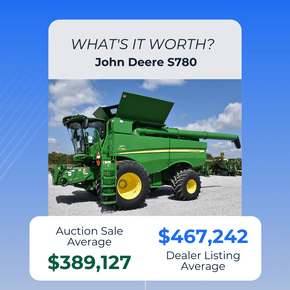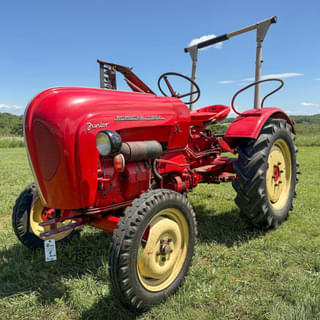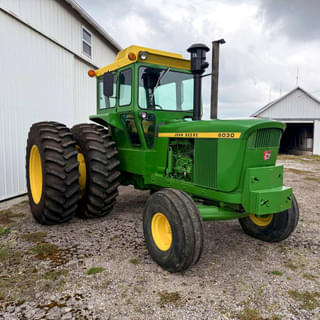In July, Tractor Zoom’s Director of Insights, Andy Campbell, had a busy month on the road, with stops at dealerships between the Midwest and East Coast, and attending events like the Dealership Minds Summit in Iowa City. These conversations with dealer principals and sales teams painted a detailed picture of what’s happening in the market right now.
This month, combines and headers are the headline makers, with notable shifts in market share, inventory age, auction trends, and buyer demand.
Combine market overview
At auction, John Deere continues to dominate the combine landscape. Since January 1, 2022, Deere machines have made up 66% of all combines sold at auction, followed by Case IH at 20%, with Gleaner and New Holland each holding about 4%.
Dealer lot sales tell a slightly different story. Since January 1, 2024, Deere’s share is just under 60%, while Case IH jumps to 30%. New Holland and Gleaner remain neck and neck at about 3% each, followed by smaller shares from brands like Fendt, Massey Ferguson, and Lexion.
When looking specifically at unsold inventory, Deere’s share climbs to 64%, with Case IH falling to 22% — a reflection of Case IH’s intentional inventory drawdown in 2024. That strategy appears to have helped CNHI keep costs under control despite industry-wide sales declines this year.

The sales patterns reinforce just how closely linked combines and headers are in the marketplace. Dealers report that when a Class 7 or 8 combine moves, a header often follows — but not always at the same pace. This summer, 4% more combines sold in the first 30 days compared to headers, a gap that underscores the urgency dealerships place on moving harvesters off the lot. That urgency helps explain why headers are stacking up faster, despite being an essential complement to the machine itself.
Auction trends: Volumes shift dramatically
Auction combine volumes have seen sharp swings over the last five years:
- 2020: 2,156 units sold
- 2021: 1,846 units sold (lowest point)
- 2022: ~2,100 units sold
- 2023: 3,115 units sold
- 2024: 3,808 units sold (interest rates up, farm economy slowing)
In 2025, January to May auction volumes are down 20% year-over-year, with 919 units sold compared to 1,115 in the same period last year. This slowdown foreshadowed an even sharper drop in the summer, where combine auction volumes are nearly 50% lower than 2020 – 2024 averages.
Bigger combines on the rise
One clear trend: Combines are getting larger. Class 8 machines surged from the fourth most common class at auction in 2020 – 2022 to the most common in both 2023 and 2024. On dealer lots, Class 9+ combines have grown from 7% to 12% of inventory between 2022 and 2025, while Class 5 and 6 shares have nearly halved, from 31% to 18%.
By value, Class 8s dominate even more. They represent 75% of total combine value on dealer lots despite accounting for just 57% of units. John Deere and Case IH lead this segment, with Case IH’s Class 8 combines carrying almost five times the value of their next largest class (Class 7).
Why combines matter so much
Although combines make up just 6% of units on dealer lots, they represent 22% of total inventory value — second only to tractors. This means each combine carries significant financial risk for a dealership, especially when inventory ages.
Class 7 combines, such as Deere’s S770, Gleaner’s S97, and New Holland’s CR9070, are showing signs of market resilience. Auction prices for these models in 2025 are trending above 2024 levels, with some units — like a 2010 CR9070 with 1,275 sep hours — nearly setting price records.
Inventory age: Class 7 vs. Class 8
Turn rates and age patterns are telling.
- Class 7: Historically, around 28% sell within 30 days of arriving on the lot, but in summer 2025, that rate has dropped to 16%. Despite this, demand remains stronger than for larger machines, and fewer Class 7 units are deeply aged.
- Class 8: Only around 10% sell within the first 30 days. A third of summer 2025 sales came from aged inventory (>360 days), and more aging is on the horizon, with significant volumes approaching the one-year mark.
Dealers are moving aged Class 8 units aggressively — often through auctions – to clear space before harvest and uncertain fall market conditions.
Header market: Following the combine trend
Dealer conversations in Northeast Iowa confirmed what the numbers suggest: Headers move as the combines go, but often at an accelerated pace. Rising costs are part of the hesitation — high-end folding corn heads can now reach $250,000. Quality, compatibility, size, and features like chopping capability all influence buyer decisions.
Row crop headers
In 2024, many dealers triggered sales at the 150 – 180 day mark, with 27% of row crop headers selling in that window. In 2025, that trigger has shifted dramatically:
- Only about 9% of row crop headers sold within 30 days this summer.
- 30% of sales came from inventory aged over a year.
This mirrors Class 8 combine patterns, where aging inventory is moved in large chunks after long periods on the lot.
Platform headers
Platform headers (including Draper and Auger types) sell slightly faster early, with 13% moving in the first 30 days, but they share the same aged-inventory problem. Nearly 30% of summer 2025 sales were for units aged over a year.
Buying and selling strategies and market signals
If you’re holding a Class 7 combine to sell, conditions may be as favorable as they’ve been in the last two years, with auction values rebounding and lot turn rates improving compared to larger machines.
Class 8 combines, however, are under continued pressure. High values, higher supply, and aging inventory make them more challenging to move quickly – and dealers are likely to continue using auctions as a key channel for clearing them before harvest.
Make more informed equipment decisions with Tractor Zoom
Whether you’re in the market for a combine, header, or another piece of equipment, having real-time insights into auction and dealer values can help you buy and sell with confidence. With Tractor Zoom’s used equipment database, you can compare listings and spot trends that affect your bottom line. Before you make your next purchase or trade, check Tractor Zoom to ensure you’re getting the right machine at the right price.












